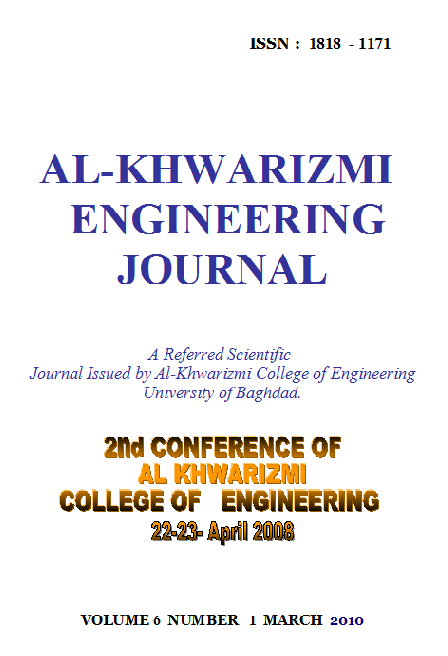The Effect of Mechanical Combined Contact Stress with Buckling Load on the Stress Distribution in the Ball and Socket Joint Mechanism
Abstract
The design of components subjected to contact stress as local compressive stress is important in engineering application especially in ball and socket Joining. Two kinds of contact stress are introduced in the ball and socket joint, the first is from normal contact while the other is from sliding contact. Although joining two long links (drive shaft in steering cars) will cause the effect of flexural and tensional buckling stress in hollow columns through the ball and socket ends on the failure condition of the joining mechanism. In this paper the consideration of the combined effect of buckling Load and contact stress on the ball and socket joints have been taken, epically on the stress distribution in the contact area. Different parameters have been taken in the design of joint. This is done by changing the angles for applied loads with the principle axis, the angle of contact between ball and socket and using different applied loads.
The problem has been solved using analytical solution for computing the critical loads and using these loads for calculating the stress distribution with finite element method using ANSYS 10. The numerical results have been compared with the experimental method using photo elasticity pattern which shows good agreement between experimental and simulation results.
Downloads
References
[2] Aleep. Robertson and Alexander H.Slocum "Measurement and characterization of precision spherical joint”.
[3] Foully A. Mohammed, Samy Zein El –Abden, Mohi Eldeen Abdel – Rahman, " A rotary flange , forming process on the lath using a ball –shaped ,mater. Process .technol, 2004.
[4] Erin Renee Roberts, (2002) " Elastic flexural- torsional buckling analysis using finite element method" . University of pittsburghat Johnstown.
[5] F.LIU, Z.M.JIN,F.hirt, c.rieker, p. Roberts and p.grigoris . “Transient elasto hydrodynamic lubrication analysis of metal – on- metal hip implautunder simulated walking conditions.
[6] ANSYS INC V 10’, ' ANSYS Manual, 2005.
[7] E.J. Hearn, (1985) "Mechanics of Material", Vol. 2, pergamon press comp, London and Northampton.
[8] Mc Master – Carr , Catalog , 473 Ridge road , Dayton , NJ08810 , USA , 2000 .
[9] Barbero, E.J., Dede, E and Jones, S., “Experimental verification of bucking mode interaction in intermediate length columns ", I. J. Solid Structures, 2000.
[10] S. Timoshinko , " Theory of elasticity stability " , 1975 .
[11] Abdel – Rahman Ragab, Salah Eldin Bayoumi, " Engineering solid mechanics fundamentals and applications " . CRC Press LLC, 2000.
[12] M. Ciavarella, D.A Hills and G. Monno, “The influence of rounded edges on indentation by a flat punch “. Proc. Inst. Mech. Engrs. Vol 212 Partc P 319, 1998.
Downloads
Published
Issue
Section
License
Copyright: Open Access authors retain the copyrights of their papers, and all open access articles are distributed under the terms of the Creative Commons Attribution License, which permits unrestricted use, distribution, and reproduction in any medium, provided that the original work is properly cited. The use of general descriptive names, trade names, trademarks, and so forth in this publication, even if not specifically identified, does not imply that these names are not protected by the relevant laws and regulations. While the advice and information in this journal are believed to be true and accurate on the date of its going to press, neither the authors, the editors, nor the publisher can accept any legal responsibility for any errors or omissions that may be made. The publisher makes no warranty, express or implied, with respect to the material contained herein.












